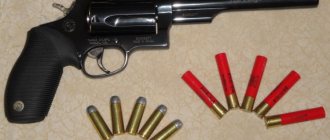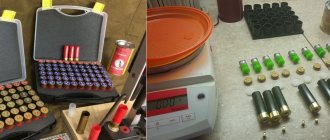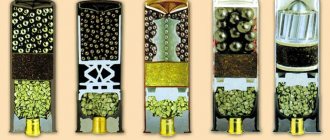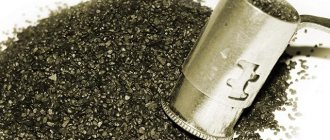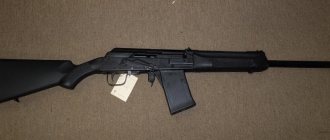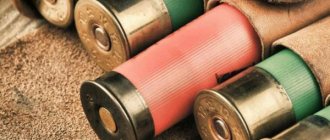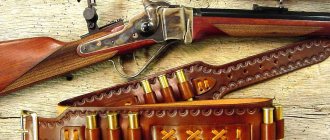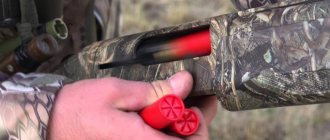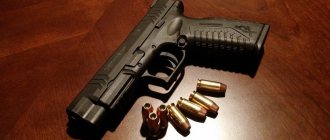- May 3, 2019
- Weapons and ammunition
- Natali Michaelis
Without properly selected ammunition, killing an animal can be extremely difficult, so many hunters prefer to use 16 gauge when hunting, the pros and cons of which will be described in our article, because it can be called almost universal. Also here you will find a short overview of ammunition from the most famous manufacturers. Such information will allow you to make your choice in order to be sure to return home with rich booty.
Reasons for the popularity of sixteen gauge
There was a time when this type of ammunition was as popular as 12 gauge, but those days are long gone. To date, reviews of the 16 gauge are significantly divided. Some hunters see in it the “golden mean” between number twenty and number twelve, which is not entirely true. Yes, the accuracy of the sixteenth caliber is quite average, which allows this type of ammunition to be used for shooting at distances from 35 to 50 meters. However, the killing power is closer to the twelfth gauge than to the middle between the twentieth and twelfth. Because of this, many novice hunters leave large wounded wounds on their prey, choosing the wrong type of cartridges and the weight of shot in them, which opponents of the sixteenth caliber are so fond of mentioning on various thematic forums. Both sides can be understood, but one fact remains undeniable. If you choose suitable cartridges for hunting, you can conduct quite successful hunting with this type of ammunition.
Positive sides
Among the undeniable advantages of the sixteenth caliber, one can highlight only its versatility. With the right amount of gunpowder or buckshot, you can go after both ducks and wild boars. You can also equip the cartridge with a special 16-caliber lead bullet, which will leave no chance of life even for an adult bear, of course, provided that it is a well-aimed shot.
In addition, this type of ammunition is almost ideal for approach hunting, since it has optimal accuracy for shooting from a distance of 35 to 50 meters. It is from this distance that shotgunning is most often carried out at most species of animals. Kill the beast and leave no strong wounded animals behind.
What guns are produced in Russia for this caliber?
Domestic manufacturers offer hunters a choice of different weapon models, for which 16-gauge ammunition is ideal.
Horizontal models
Double-barreled shotguns are in demand among hunters. Their diversity allows everyone to choose the most optimal option, which will not let you down at the most crucial moment and will not create inconvenience.
The following horizontal models fire sixteen-gauge cartridges:
- "IZH-58". The gun is considered one of the best examples of the domestic model. It is perfect for hunters who are just starting to master this business. 16 gauge weapons have a special lock with a safety lock that prevents an accidental shot. The model has an interesting modification, complemented by an ejector.
- "IZH-43". The model differs from the guns discussed above in the presence of a universal double-trigger trigger mechanism. This means that a person, if desired, can fire in both single-trigger mode and autonomous mode. Also, 16-gauge weapons are distinguished by improved quality and high reliability.
Even beginners can work with the latest model, as it significantly reduces the common mistakes they make.
Vertical models
The weapon has a big advantage: it will not be possible to fire an “unplanned” shot.
16-gauge bullets are also suitable for vertical models. Domestic manufacturers are also producing them.
The main advantage of vertical models over horizontal ones is that they provide a good overview. But they are very difficult to shoot during strong winds.
The following 16 gauge weapon models have become the most popular:
- "MR-27". The hunting rifle is characterized by the presence of an internal trigger trigger, as well as a reliable pistol stock. The model is equipped with fuses that protect against accidental shooting.
- "TOZ-34". The main difference between the model and the previous one is the special type of barrel locking. In this case, it is carried out using a wedge along with sector protrusions.
Negative sides
This type of ammunition is highly not recommended for novice hunters to use for hunting, since choosing the optimal amount of gunpowder and shot to kill an animal, but at the same time leaving it with trophy value, will be extremely problematic. With twenty and twelve gauges everything is much simpler.
Also, many arms factories today give preference to 12-gauge shotguns, so choosing a reliable “companion” for hunting will be very difficult. One of the best double-barreled shotguns for beginners is considered to be the 16-gauge TOZ BM with a horizontal barrel arrangement. It has decent technical characteristics and is unpretentious in operation.
Negative qualities
Hunters claim that due to the lack of supply of specialized stores with the 16th format, many have switched to the 12th category. If during a hunt they run out, it’s difficult to take the necessary charges, your partners don’t have them in stock.
Express partial claims regarding:
- Too narrow a range of living creatures that can be hit without problems.
- The design of guns is complex , which is why it is not recommended for beginners to learn to use them.
- Not suitable for long-range shooting due to accuracy characteristics .
- Relatively little sharpness of the battle.
There has never been a clear attitude towards 16 gauge. Some people like the IZH 12 for its sighting bar, while others think this property is negative. The attitude is constantly influenced by the individual characteristics of both the model and the hunter himself.
How to choose shot cartridges?
The choice of 16-gauge cartridges for hunting should be approached with great responsibility, since the success of this event will depend on the correctly selected ammunition. To do this, you should take into account many features and nuances, one of which is the accuracy indicator. The larger it is, the longer the shot will retain its original shape after firing. It seems that you should always try to choose ammunition with maximum accuracy? But no! When hunting for flying birds, it is necessary to use ammunition with a good spread of shot so that you have the opportunity to hit a moving target. In addition, too much grouping can reduce the trophy quality of the prey.
It is also necessary to take into account the weight of gunpowder and shot in the ammunition. The more gunpowder contained in the case, the further the ballistic projectile will fly, maintaining its accuracy. If you are not very knowledgeable about attachments, then pay attention to the recommended shooting distance indicator. You need to know the approximate distance from which you will shoot at your prey while hunting. For example, for duck hunting, it will be enough to choose ammunition designed for shooting from a distance of 20 to 30 meters. And when hunting a large animal, you need to stay away from it, so you should purchase cartridges with a large amount of gunpowder or those loaded with a bullet.
Domestic cartridges for hunting
If we look back a little, cartridges for hunting smooth-bore weapons were mainly produced by such large ones as the Biysk Chemical Plant (BHC), and, perhaps, that’s all. Small manufacturers had very little impact on the overall ammunition shortage, especially in remote areas. Now this picture has changed dramatically, and the domestic market has been replenished with new cartridge manufacturers, who have managed to saturate the market relatively well with cartridges for hunting smooth-bore weapons in a short period of time. This was also facilitated by the appearance of foreign cartridges in the country, even from such well-known manufacturers on the world market as Dynamite Nobel and Winchester, and they have a fairly stable demand, despite their high cost.
Of the domestic manufacturers of hunting cartridges for smooth-bore weapons, I would like to put in first place , which produces hunting cartridges under the Taiga brand with various numbers of shot, buckshot and Polev bullets. I have already written enough about this company in the magazine and therefore I will not dwell on it in detail. I will only say one thing: when loading their cartridges, they use foreign casings, primers and gunpowder, hence the good ballistics of these cartridges.
One of the largest domestic manufacturers of hunting cartridges for smoothbore guns is Nauchno-Proizvodstvennaya, located in the Moscow region (Krasnozavodsk). This company produces standard hunting cartridges and magnum cartridges of 12, 20 and .410 caliber, and 16-gauge cartridges are manufactured only in the usual version, that is, with a maximum pressure ranging from 470-570 kgf/cm2. The characteristics of these cartridges are given in Table 1. The ballistic indicators given in this table were obtained as a result of averaging the data from acceptance tests of batches of cartridges manufactured by NPF Azot in 1996 (Table 1). Hunters very often see sporting cartridges on store shelves for shooting at round and trench stands. Cartridges with the names TRAP and SKEET are used for training and improving sportsmanship, cartridges with the names AZOT TRAP and AZOT SKEET are elite target cartridges for training high-class athletes and international competitions. I do not recommend using these cartridges for shooting in hunting rifles designed for a standard charge.
It also produces hunting cartridges of 12, 16, 20 and .410 calibers, which are intended for checking the control and measuring complex during ballistic tests of cartridges and powders and certification of smooth-bore ballistic guns, from which, in fact, various batches of loaded cartridges are subsequently tested and selection of ballistic characteristics for setting the weights of projectiles and charges when setting up equipment factory lines. We also produce 12-gauge test cartridges to test the strength of magnum-type hunting rifles and sporting shotguns. The production of shot and buckshot, as well as the loading of cartridges, is carried out on Italian equipment in domestic primed plastic cartridges (domestic capsule) with wads of design.
Hunting cartridges of all calibers are manufactured with shot from No. 9 to 4/0, with buckshot from 6.2 to 8.5 mm and with Azot bullets (12, 20 and .410 calibers), Poleva-2, Vyatka and "Arrow". Cartridges can have high metal bases or low ones.
The second capital of Russia, as St. Petersburg is called, also did not stand aside. The NPP Pirobaltpus enterprise produces hunting shotgun and slug cartridges of 12, 16 and 20 calibers with a plastic sleeve for the chambers of smooth-bore shotguns with a length of 70 mm. The average flight speed of a shot 10 meters from the muzzle of the barrel is 320 m/s, and a bullet is 385 m/s. The average maximum pressure does not exceed 65 MPa for 12 gauge, 68 MPa for 16, and 72 MPa for 20 gauge.
It should be noted that hunting cartridges from this manufacturer have KV-21 and KV-22 primers, which are also manufactured in St. Petersburg at the Krasnoznamenets State Research and Production Enterprise. The ignition composition of the primers is non-corrosive and, as this company reports, has increased “burning power”, which eliminates failures in ignition of the powder charge of almost any hunting powder at temperatures down to minus 50 ° C. The KV-21 brand capsule is manufactured in Zhevelo dimensions for the domestic market of Russia and the CIS countries. The KV-22 brand capsule is made according to European sizes, which allows them to be used in cartridge cases manufactured by leading countries in Europe and America. The energy of failure-free operation of the capsule is 0.25 Joule. The capsule ensures reliable ignition of a powder charge consisting of smoky and smokeless powders such as DOP, Sokol, Sunar, over a wide temperature range. Some technical characteristics of hunting cartridges produced by this manufacturer are given in Table 2.
In the Tambov region (Kotovsk), only 12-gauge hunting shotgun cartridges with shot and buckshot of various sizes are manufactured for shotguns with chambers 70 mm long. A plastic sleeve with a primer made in France, Salyut-4 or Sunar gunpowder, a polyethylene wad container and gaskets made of celluloid or other polymer materials. The Kotovsky Plastics Plant itself produces Salyut-4 pyroxylin powder, which is used to load its cartridges. Manufacturers of gunpowder claim that it produces less noise when fired and has a lighter powder charge. This powder can be used to equip 12, 16 and 20 caliber cartridges. The 12-gauge cartridges on sale have a shot velocity 10 meters from the muzzle of the barrel in the range of 330-340 m/s with a maximum pressure of no more than 67 MPa. The weight of the shot is from 30 to 36 g, and the weight of gunpowder is 1.6-2.2 g, depending on the batch used. The same enterprise produces container wads with cardboard lining in 10, 12, 16, 20, 28 and 32 calibers made of polyethylene. Shot gaskets of the same sizes are made from various polymer materials.
In the city of Zelenodolsk (Tatarstan), the Sergo Plant produces hunting cartridges of 12 gauge with a plastic sleeve 70 mm long, primed with both domestic and foreign-made capsules. The cartridges used as projectiles are shot weighing 33 g from No. 7 to 4/0, buckshot with a diameter of 5.5 to 8.5 mm and Polev design bullets weighing 30 g. The sports cartridge is loaded with shot No. 7-9 weighing 24 g. Pressure in sports cartridges it can reach 90 MPa, and in hunting cartridges - 70 MPa. The shot speed in a sports cartridge is 330-335 m/s, in shotgun cartridges it is 320-325 m/s, and the bullet speed is 375-380 m/s. These cartridges are sold under the Pozis brand.
Well, the last manufacturer of hunting cartridges that we should focus on is the NPF Tahoe enterprise (Kherson). It produces standard, magnum, classic, turbo standard and sports cartridges.
Standard cartridges are designed for shooting from ordinary 12-gauge hunting rifles, the operating pressure of which is 65 MPa. The pressure in shot cartridges from this manufacturer is 60 MPa and 65 MPa in 12-gauge buckshot and bullet cartridges; in 16-gauge shot and buckshot cartridges the pressure is no more than 65 MPa, and in bullet cartridges - 70 MPa. The pressures in 20-gauge cartridges are the same as in 16-gauge cartridges, only buckshot cartridges have a pressure of up to 70 MPa. All standard cartridges are loaded with shot from No. 9 to 4/0, buckshot and bullets. The weight of a shot in 12 gauge is 32 g, buckshot is 28 g, and a bullet weighs 32 g, the speed of which is 410 m/s, the speed of a shot at 10 meters is 360 m/s, and buckshot is 380 m/s. In 16-gauge cartridges, the weight of shot and bullet is 28 g, and buckshot is 25 g. The velocities of shot, buckshot and bullet are respectively 360, 390 and 430 m/s. For 20-gauge cartridges, the weight of shot and bullet is 24 g, and buckshot is 22 g. The projectile velocities are the same as for 16-gauge cartridges. All of these cartridges are designed to be fired from shotguns with a 70mm chamber.
Magnum cartridges can only be used in 12-gauge shotguns that are certified to fire cartridges with a working pressure of 95 MPa. Such shotguns usually include sporting and magnum shotguns, designed to handle increased shot weights and increased pressure. Magnum cartridges are available with sleeves 70 and 76 mm long, which use shot from No. 9 to 4/0 in 12 and 20 caliber cartridges, and in .410 caliber the shot has numbers from 7 to 3. In 12 gauge cartridges, shot is used weighing 50 g (speed of the order of 390 m/s at 10 m from the muzzle), buckshot and bullets in these cartridges weigh 37 g, and the speed of bullets is 430 m/s, for buckshot - 400 m/s at a maximum pressure not exceeding 85 MPa in gun chambers. 20 gauge cartridges have a shot velocity of 380 m/s, buckshot - 400, and bullets - 430 at a pressure of 80-85 MPa. The weight of a shot shell is 34 g, a buckshot shell is 28 g, and a bullet weighs 30 g. The weight of shot in .410 caliber cartridges is 21 g, buckshot is 10 g, and a bullet weighs 9 g. Pressures are in the range of 95-105 MPa. The speed of shot is 420 m/s, buckshot is 500 m/s, and bullet speed is 540 m/s.
Classic cartridges are available in 12, 16 and 20 calibers and all have a pressure not exceeding 32 MPa, and are therefore intended for firing from antique guns, the stamps on which indicate that they can only be fired with black powder. Cartridges of this class provide a standard fight with a normal shot shell weight, that is, they are the same as those found in standard cartridges, however, the speeds are somewhat reduced, for example, in 12 gauge shot shells on average - by 30 m/s, buckshot - by 50 m/s, and bullets at 70 m/s. This is not so much, considering that the working pressure is almost halved. Shot speeds in 16 gauge are 320 m/s with a shot weight of 28 g, buckshot - 330 m/s, and bullets - 380 m/s. In 20 gauge, with a shot weight of 24 g, the speed is the same as in 16 gauge, and buckshot and bullet have speeds of 340 and 350 m/s, respectively.
There is some deviation from the usual characteristics of cartridges called “turbo standard”, which are manufactured in 12, 16 and 20 calibers with a case length of 70 mm. These cartridges have shot shells in 12 gauge weighing 40 g with a speed of 10 m equal to 330 m/s (the maximum pressure does not exceed 60 MPa). In 16 gauge, the weight of the shot is 36 g at a speed of 330 m/s (pressure 65 MPa), and in 20 gauge the weight of the shot shell is 30 g at the same speed (pressure 70 MPa). When equipped, shot from No. 9 to 4/0 is used in all cartridges. 12-gauge sporting cartridges for shotguns with a 70 mm chamber are made with shot No. 7.5 for a trench stand (trap) and with shot No. 9 for a round stand (skeet).
So, it is known what kind of cartridges are produced in our country. Now let's move on to the question of their use in hunting, depending on the shooting range and what kind of animal we need to shoot.
The general approach to the problem of shooting distance is that for long-range shooting (about 45-50 m) from barrels with at least a half-choke (although a strong choke is preferable), you should choose cartridges with a container. For shooting at medium distances (35-40 m), cartridges should be used with regular projectiles without choke or choke containers. Shooting at close ranges is permissible from cylinders, but with cartridges equipped with wads that have devices for increased shot dispersion. Such devices, in particular, have Taiga cartridges. Now let's consider the question of what shells should be used when hunting certain types of game.
Characteristics of Nitrogen cartridges
For large animals such as elk, wild boar, and bear, heavy Brenneke-type bullets weighing about 36 g should be used. For shooting deer, medium-sized elk or wild boar, lighter bullets weighing about 25-30 g can be used. For hunting gilts, wolves and the like Depending on the size of the animals, large and medium buckshot (about 8-6 mm) can be used. Even when shooting at a goose, they manage to use small buckshot, although this is not recommended, since a buckshot shot at a long distance guarantees only an accidental hit, but large shot should certainly be used on such hunts, but you need to shoot at completely acceptable distances, and not at sky-high heights. It is best to use cartridges with one or four zeros for goose hunting. The largest shot should be used when hunting very large goose and shot from long barrels with strong choke constrictions. The same weapons and cartridges should be used when hunting foxes from the approach, and smaller shot can be taken from under a hound. Sometimes you can even use shot No. 3, but if the cartridge has good characteristics in terms of speed and accuracy (cartridge only with a container), and the gun has long barrels (at least 750 mm) and powerful chokes, and the range to the fox is no more than 30 m.
If a hare is shot from under the hounds, then you can use shot No. 5, and in the fall from the approach - No. 3, 4, but in winter it is better to have cartridges with shot No. 2 or 1. The capercaillie should be shot with shot No. 2 or 1, naturally, at the permissible distance, otherwise you won’t be able to reach it with buckshot. It is best to shoot black grouse with shot No. 3; you can, of course, use smaller ones, but not always, except perhaps at broods from under a dog. Hazel grouse should be taken with 7 or 8 fraction numbers. For wild pigeons it is enough to use cartridges with shot No. 7-5, and for doves with a smaller number. When hunting ducks, you should stock up on cartridges with shot No. 5-7, and if you come across a large one, then it is not forbidden to use a C grade. There are still many different types of hunting objects, but the recommendations given here will allow you to figure out which shot should be used depending on the size of the animal or bird.
M. BLUM
Source: ohoter.ru
About
Polev's cartridges
Who hasn't heard of the famous Polev bullets, which are widespread not only in the countries of the former Soviet Union, but also in the West? The ammunition got its name from the designer V.V. Polev, who created it. The range includes not only cartridges with bullets, but also shot, and even buckshot with various weights of gunpowder, which allows you to choose the best option for hunting almost any animal. A distinctive feature of Polev's ammunition is that the cartridge case is equipped with a special plastic container, which is separated from the main part of the cartridge case after the shot. This helps maintain shot accuracy at a distance of more than 50 meters.
Loading 12 gauge duck cartridges
Loading 12 gauge cartridges depends on the method of hunting and the personal preferences of the hunter. To load cartridges yourself, you will need cartridges, primers, gunpowder, shot, wads and precise scales that measure weight to tenths of a gram.
How to load the cartridge itself:
- new plastic or paper sleeves are taken, because old ones can tear and burn out at the moment of firing, thereby reducing the sharpness of the battle;
Attention! For spring hunting, take new plastic cartridges to protect the cartridges from swelling in high humidity.
- a capsule is inserted into the sleeve;
- the required amount of gunpowder is weighed out (follow the instructions on the gunpowder can);
- a wad (several wads, a wad container) is placed on the gunpowder;
- fraction is poured in. You can take measurements for it so you don’t have to weigh it every time;
- press the shot with a hammer;
- make a star twist;
- mark the cartridge.
"Brenneke"
German-made cartridges that are ideal for hunting with IZH-27 16 caliber or any other gun designed for this type of ammunition. It’s worth noting right away that the cost of Brenneke shot cartridges leaves much to be desired, however, their quality is excellent. The company has been producing ammunition for over 100 years, establishing itself as one of the best European manufacturers. The main advantages of the Brenneke are its high accuracy of fire and good stabilization during flight, which is especially important when shooting through dry grass or branches. Bullets have a very intricate shape, so it is not possible to upgrade the ammunition by adding additional powder, because even a minor flaw can lead to catastrophic consequences.
"Sheddit"
Among Russian hunters, 16 gauge cartridges of this brand are especially popular. Their only drawback is their relatively high cost, but they have almost the same destructive power as magnum cartridges and weigh only 28 grams. The initial energy indicator also has quite good values, which allows the Sheddit to be used for hunting even grizzly bears. The company also produces various modifications that can satisfy the requirements of the most demanding hunters.
"Tacho"
One of the most inexpensive types of imported ammunition, which was used by the 2000 Olympic champion N. Milchev during sports shooting competitions. The main advantage of this company’s products is the stability of the combat, as well as pinpoint accuracy when loading cartridges. The stores offer ammunition with shot numbers from 4 to 9 (great for duck hunting). In addition, the company also produces samples loaded with bullets or buckshot. The length of a lead bullet for a 16 gauge case is approximately 32 grams.
Seasonal features
As already mentioned, the shot is selected not only according to the size of the ducks, but even for each season separately. This is due to the physiological characteristics of ducks.
Read about how to properly hunt ducks in the fall.
In the tables below you will see which shot is suitable, depending on the time of year, for hunting different types of ducks.
Autumn
In September the bird is more frightened, it is not as carefree as at the beginning of the season, so it does not let the hunter get too close. In October, the birds had already moulted and gained fat. The optimal shot for different birds lies in the range Nos. 5-3.
| Types of ducks | September | October - season closes |
| Scoter, red duck, merganser, blue hawk, shelduck | 4 | 4-3 |
| Mallard, goldeneye, pintail, gadwall, wigeon, white-eyed pochard, red-headed pochard | 5-4 | 4 |
| Lutok, teal, shoveler | 6 | 5 |
Spring
In the spring, hunting is not allowed everywhere and only for drakes, which are taken with bait or stuffed animals.
| Types of ducks | Spring |
| Scoter, red duck, merganser, blue hawk, shelduck | 4 |
| Mallard, goldeneye, pintail, gadwall, wigeon, white-eyed pochard, red-headed pochard | 4-5 |
| Lutok, teal, shoveler | 6 |
Summer
In August, when the hunt opens, the young of the year are not shy - they allow hunters to come close, they have not yet moulted or gained fat.
| Types of ducks | August |
| Scoter, red duck, merganser, blue hawk, shelduck | 5 |
| Mallard, goldeneye, pintail, gadwall, wigeon, white-eyed pochard, red-headed pochard | 5 |
| Lutok, teal, shoveler | 7 |
"Glavpatron"
Domestic-made ammunition produced by the Tula plant, known in our country as one of the most reliable manufacturers. Most hunters prefer to purchase products from this company only due to the fact that they have a low cost, although one cannot fail to note their quite good technical characteristics. "Glavpatron" pleases its consumers with an excellent rate of fire and high combat stability.
This brand produces both sporting and hunting ammunition of the following varieties:
- magnum and semi-magnum;
- classic;
- special;
- standard;
- bullets.
Among the assortment you can find varieties with or without a wad container, so you can easily select ammunition for professional or amateur hunting. The prices are reasonable, the quality is at the highest level - what else does a Russian hunter need?
What types of hunting cartridges are there?
Cartridges differ in the material from which the sleeve is made; it can be metal, cardboard or plastic. Currently, the most common is a plastic sleeve. Nowadays, metal and cardboard cartridges are used only by classic lovers who load their cartridges themselves.
Cartridges differ in the type of gunpowder, which can be smoked or smokeless. Currently, the vast majority of cartridges are equipped with smokeless powder, which is superior to black powder in all main indicators.
Cartridges vary according to the type of projectile and can be: shotgun, buckshot and bullet. Bullet cartridges are used for hunting large animals. Buckshot is used when hunting smaller animals. Shot cartridges are the most common and are used for hunting birds and small animals. The shot in cartridges can be lead or steel. Steel shot is currently not very common in our country, but in many foreign countries it is mandatory when hunting waterfowl. The shot used in the cartridge can be of different numbers, from the smallest N 12 (1.5 mm) to the largest N 0000 (5 mm).
Cartridges vary in caliber and case length. The most common calibers: 12, 16 and 20. Less common: 10, 28, 24, 410. According to the length of the cartridge case, cartridges can be: 65 mm, 70 mm, 76 mm, 89 mm.
The cartridges differ in the weight of shot, which in hunting cartridges can be from 28 grams to 56 grams (magnum cartridges). When choosing a shot load, you should consider what kind of hunting you are going to use this cartridge for. It must be taken into account that the larger the shot load, the stronger the recoil of this cartridge.
"Techkream"
This Russian company has been producing hunting ammunition for 50 years. Among the assortment you can find a lot of shot and bullet cartridges with different amounts of gunpowder and the diameter of the ballistic projectile. The main advantage of Techkrim products is the ideal ratio of quality and price, which makes the cartridges popular among amateurs and professionals.
"SCM"
A domestic company engaged in the production of standard ammunition, as well as magnum cartridges. This is the only Russian manufacturer that produces shot cartridges designed for ultra-long range shooting, which makes them quite unique.
In the last few years, guns with chamber lengths of 70 millimeters have become widely known around the world, which contributed to the development of the enormous popularity of ammunition from SCM, since only one Russian company produced 70 mm cartridges. In addition, the products are distinguished by truly good quality, which is ensured through strict control during the production process. For example, when each batch of ammunition is released, ballistic tests are carried out, which makes it possible to almost completely eliminate the appearance of defective products on the market.
"Fetter"
Just recently purchased an IZH 16-caliber shotgun for hunting and don’t know what cartridges are best to use? It is worth noting that this type of weapon is not particularly fancy, so it is best to “feed” the gun with domestically produced cartridges, and not with expensive imported analogues, which, although they have good technical characteristics, are prohibitively expensive.
The products are in great demand on the Russian market, especially when it comes to large calibers (10, 12, 16). In addition, the company produces cartridges for sport shooting, so not only hunters will have something to find here.
Magnum cartridges, which are distinguished by their compact cartridge case and relatively low weight, are very popular. The bullet diameter is only 16 millimeters and the weight is 34 grams. Although you can find lighter samples among the offered assortment.
Positive points
There is a lot of debate regarding calibers, which one is better, but regarding 16 fans are not decreasing. Popularity is maintained due to:
- Good power.
- Practicality.
- Combat sharpness.
- Optimal technical characteristics.
It is convenient to move through the bushes with the gun due to its light weight category. For example, a 12-gauge weapon is heavy and more difficult to carry. Therefore, the advantages can confidently be attributed to:
- The arrival of fundamentally new mechanisms in this area of weapons.
- Good accuracy at medium or short range.
- Low return.
- Small weight of the gun.
It is believed that the revival of 16 gauge began with the improvement of the pump-action Bekas . The designers spent a long time selecting the size of cartridges for it, improving the channel, when they remembered the undeservedly forgotten caliber, they decided that it would be useful not to change, but to supplement such parameters. After production was restored, they began to produce again:
- Ammo.
- Shells.
- Wads.
- Containers - 16 gauge.
The light weight of the gun with its equipment and the corresponding powder load allows you to hunt comfortably with little recoil, which even women and teenagers can cope with, accumulating skills. Conflicting opinions are received regarding the effectiveness of the shooting. It all depends on a competent approach to the brand of weapon, its characteristic parameters and handling skills. From the reviews it is clear that you can catch a large animal if you know where to hit at a distance of 35 m .
"Record"
Well, the last brand of cartridges that we will consider today is domestic “Record” ammunition, which is used, perhaps, by the overwhelming majority of Russian hunters, despite certain shortcomings. This popularity is due to the lowest price on the market, but for most people the decisive factor when choosing is the financial component. Yes, better materials could have been used. Yes, there could be fewer misfires, but we are pleased with the large assortment that will allow the hunter to choose ammunition to suit his taste. For example, you can purchase shot, slug or buckshot cartridges, the ballistic projectile of which is made of materials: rubber, steel, lead.
As you can see, there are quite a few companies that produce 16 gauge ammunition. Despite the fact that this variety has already lost its relevance and is unlikely to return, many hunters continue to use the sixteenth caliber to this day. Perhaps it’s a matter of habit or a desire to stand out from the gray mass - it doesn’t matter. This caliber is fully justified during hunting and even has a number of advantages over its competitors. Therefore, we sincerely hope that our article helped you decide on the choice of suitable ammunition, because this is precisely the goal we pursued.
